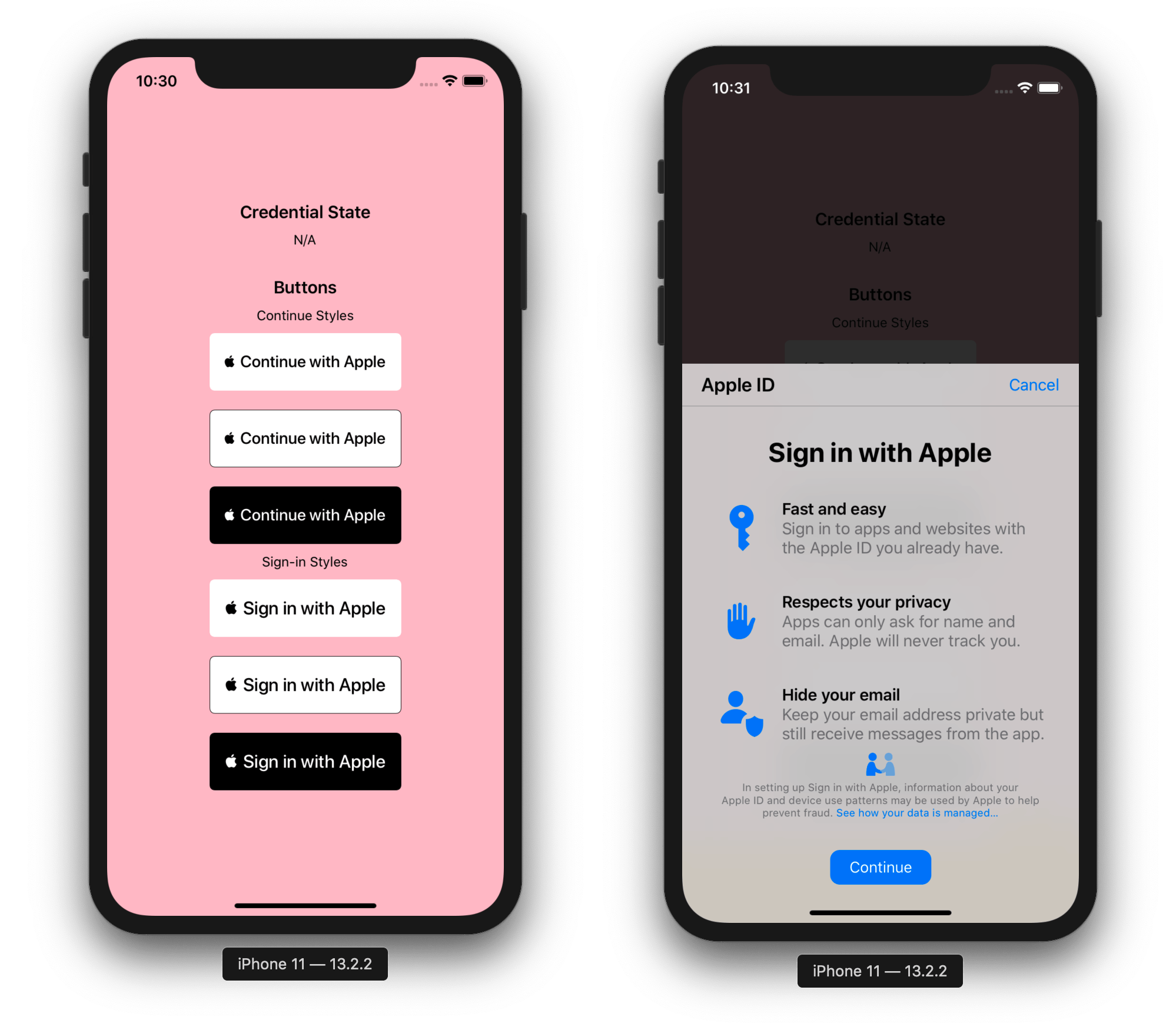A well typed React Native library providing support for Apple Authentication on iOS, including support for all AppleButton variants.
The @invertase/react-native-apple-authentication library will not work if you do not ensure the following:
-
You have setup react-native iOS development environment on your machine (Will only work on Mac). If not, please follow the official React Native documentation for getting started: React Native getting started documentation.
-
You are using React Native version
0.60or higher. -
You are using Xcode version
11or higher. This will allow you to develop using iOS version13, the only version possible for authenticating with Apple. -
Once you're sure you've met the above, please follow our Initial development environment setup guide.
yarn add @invertase/react-native-apple-authenticationYou will not have to manually link this module as it supports React Native auto-linking.
Below are simple steps to help you get up and running. Please skip and head to the full code examples noted below if you prefer to see a more complete implementation:
- React Hooks example
- React Class example
- If you're authenticating users via
React Native Firebase; see our Firebase guide
Import the appleAuth (API documentation) module and the AppleButton (API documentation) exported member element from the @invertase/react-native-apple-authentication library. Setup an event handler (onPress) to kick start the authentication request.
// App.js
import React from 'react';
import { View } from 'react-native';
import { AppleButton } from '@invertase/react-native-apple-authentication';
async function onAppleButtonPress() {
}
function App() {
return (
<View>
<AppleButton
buttonStyle={AppleButton.Style.WHITE}
buttonType={AppleButton.Type.SIGN_IN}
onPress={() => onAppleButtonPress()}
/>
</View>
);
}Import exported members AppleAuthRequestOperation (API documentation), AppleAuthRequestScope API documentation & AppleAuthCredentialState API documentation.
// App.js
import appleAuth, {
AppleButton,
AppleAuthRequestOperation,
AppleAuthRequestScope,
AppleAuthCredentialState,
} from '@invertase/react-native-apple-authentication';
async function onAppleButtonPress() {
// performs login request
const appleAuthRequestResponse = await appleAuth.performRequest({
requestedOperation: AppleAuthRequestOperation.LOGIN,
requestedScopes: [AppleAuthRequestScope.EMAIL, AppleAuthRequestScope.FULL_NAME],
});
// get current authentication state for user
const credentialState = await appleAuth.getCredentialStateForUser(appleAuthRequestResponse.user);
// use credentialState response to ensure the user is authenticated
if (credentialState === AppleAuthCredentialState.AUTHORIZED) {
// user is authenticated
}
}Set up event listener for when user's credentials have been revoked.
// App.js
import React, { useEffect } from 'react';
import { View } from 'react-native';
import appleAuth, { AppleButton } from '@invertase/react-native-apple-authentication';
function App() {
useEffect(() => {
// onCredentialRevoked returns a function that will remove the event listener. useEffect will call this function when the component unmounts
return appleAuth.onCredentialRevoked(async () => {
console.warn('If this function executes, User Credentials have been Revoked');
});
}, []); // passing in an empty array as the second argument ensures this is only ran once when component mounts initially.
return (
<View>
<AppleButton onPress={() => onAppleButtonPress()} />
</View>
);
}// App.js
import { View, Button } from 'react-native';
import appleAuth, {
AppleAuthRequestOperation,
AppleAuthCredentialState,
} from '@invertase/react-native-apple-authentication';
async function onLogout() {
// performs logout request
const appleAuthRequestResponse = await appleAuth.performRequest({
requestedOperation: AppleAuthRequestOperation.LOGOUT,
});
// get current authentication state for user
const credentialState = await appleAuth.getCredentialStateForUser(appleAuthRequestResponse.user);
// use credentialState response to ensure the user credential's have been revoked
if (credentialState === AppleAuthCredentialState.REVOKED) {
// user is unauthenticated
}
}
function App() {
return (
<View>
<Button onPress={() => onLogout()}>log out</Button>
</View>
);
}- appleAuth module
- AppleAuthRequestOptions
- AppleAuthRequestResponse
- AppleAuthRequestResponseFullName
- AppleButtonProps
- AppleAuthCredentialState
- AppleAuthError
- AppleAuthRealUserStatus
- AppleAuthRequestOperation
- AppleAuthRequestScope
- AppleButtonStyle
- AppleButtonType
- Why does
full nameandemailreturnnull?- Apple only returns the
full nameandemailon the first login, it will returnnullon the succeeding login so you need to save those data. - For testing purposes, to be receive these again, go to your device settings;
Settings > Apple ID, iCloud, iTunes & App Store > Password & Security > Apps Using Your Apple ID, tap on your app and tapStop Using Apple ID. You can now sign-in again and you'll receive thefull nameand `email.
- Apple only returns the
- See LICENSE
Built and maintained with 💛 by Invertase.
💼 Hire Us | ☕️ Sponsor Us | 💻 Work With Us







